Catalpas Tree
- November 13, 2023
- 0 comment
The catalpa tree, belonging to the Bignoniaceae family, is a distinctive and ornamental deciduous tree known for its large heart-shaped leaves and showy clusters of fragrant flowers. Native to North America, specifically the eastern United States, the catalpa tree has found its way into various landscapes and gardens around the world.


The most commonly recognized species include the Southern catalpa (Catalpa bignonioides) and the Northern catalpa (Catalpa speciosa). These trees are recognized for their rapid growth, making them popular choices for shade and ornamental purposes. The catalpa’s unique characteristics extend to its long, slender seed pods, colloquially referred to as “cigar trees,” due to their elongated shape.
These pods persist into the winter, adding an intriguing element to the tree’s overall aesthetic. Catalpas are also valued for their resilience, adapting well to different soil types and weather conditions. Beyond their horticultural appeal, catalpa trees have historical significance, with indigenous people and early settlers utilizing various parts of the tree for medicinal and practical purposes. Overall, the catalpa tree stands as a captivating and resilient presence in the natural landscape, offering both visual allure and a nod to cultural and historical connections.
| Characteristics | Description |
| Family | Bignoniaceae |
| Genus and Species | Catalpa bignonioides (Southern Catalpa) |
| Catalpa speciosa (Northern Catalpa) | |
| Common Names | Catawba, Indian Bean Tree, Cigar Tree |
| Native Range | Eastern United States |
| Growth Habit | Deciduous tree |
| Height | Up to 40-70 feet (12-21 meters) |
| Spread | 20-40 feet (6-12 meters) |
| Leaves | Large, heart-shaped |
| Flowers | Showy clusters, fragrant |
| Bloom Time | Late spring to early summer |
| Fruit | Long, slender pods often called “cigar trees” |
| Hardiness Zones | 5 to 9 |
| Soil Requirements | Adaptable; prefers well-drained soil |
| Sun Exposure | Full sun to partial shade |
| Growth Rate | Fast |
| Uses | Ornamental, shade, and street tree |
| Special Features | Resilient, historical significance |
Botanical Beauty of Catalpa Trees
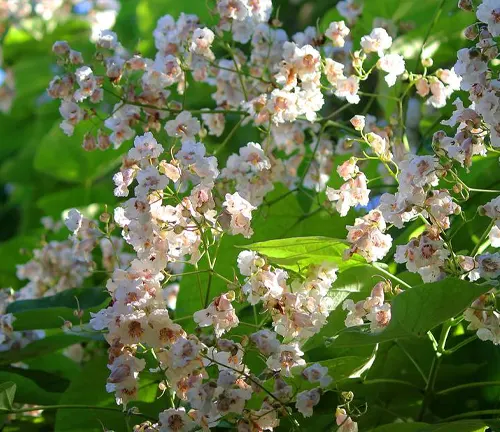
The Catalpa tree, with its botanical charm, stands as a testament to nature’s artistry. Belonging to the Bignoniaceae family, this deciduous wonder graces landscapes with its large, heart-shaped leaves and clusters of fragrant flowers. The Southern Catalpa (Catalpa bignonioides) and the Northern Catalpa (Catalpa speciosa) are the most recognized species, each contributing to the tree’s allure. The distinctive shape of its leaves and the captivating sight of its blossoms make the Catalpa tree a true botanical beauty, enhancing the aesthetic appeal of any environment lucky enough to host its presence.
Woodland Elegance
In the realm of trees, the Catalpa stands out as a symbol of woodland elegance. With heights reaching up to 70 feet and a spread of 40 feet, this deciduous giant commands attention. Its gracefully arching branches create a canopy of shade, offering a respite from the sun’s rays. The Catalpa’s long, slender seed pods, often likened to cigars, dangle delicately, adding a touch of whimsy to its overall elegance. Whether standing alone or in clusters, the Catalpa tree evokes a sense of natural sophistication, making it a favored choice for landscaping enthusiasts seeking both beauty and stature.
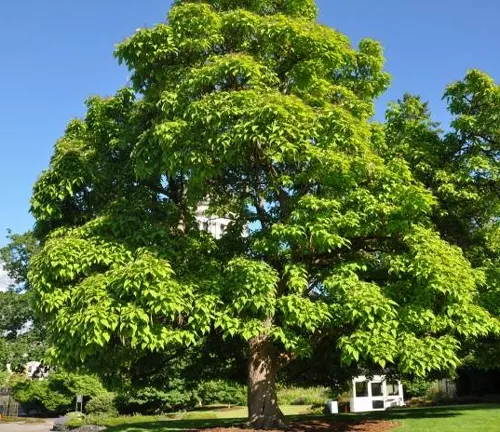
Ecological Importance
Beyond its visual appeal, the Catalpa tree plays a crucial role in the ecological tapestry. Indigenous to the eastern United States, this tree contributes to the biodiversity of its native habitats. Its leaves provide nourishment for various herbivores, and its flowers attract pollinators, fostering a healthy ecosystem. As a deciduous tree, the Catalpa also contributes organic matter to the soil through the shedding of leaves, enriching the surrounding environment. Recognizing the ecological importance of Catalpas adds depth to our appreciation of their presence in natural settings.

Cultivation and Conservation
Cultivating Catalpa trees is a rewarding endeavor, thanks to their adaptability and fast growth. Thriving in hardiness zones 5 to 9, these trees prefer well-drained soil and can tolerate a range of conditions. Conservation efforts are vital to ensure the preservation of Catalpa species, especially considering their historical and ecological significance. By understanding the optimal conditions for growth and promoting sustainable practices, enthusiasts can contribute to the conservation of these remarkable trees.
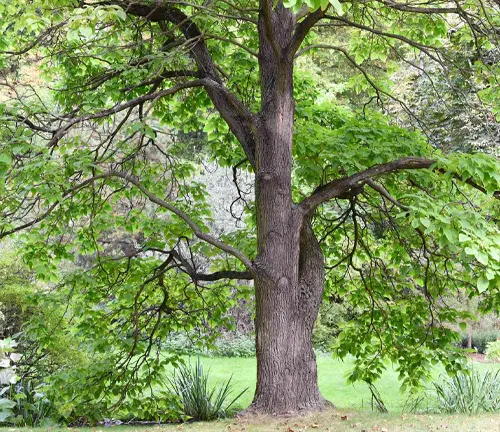
Fragrance
One cannot speak of Catalpa trees without acknowledging their fragrant blooms. Late spring to early summer sees the Catalpa adorned with showy clusters of flowers that emit a sweet and alluring fragrance. The scent not only captivates human admirers but also serves as a beacon for pollinators. Bees and butterflies, drawn by the enticing aroma, contribute to the tree’s reproductive cycle. The fragrance of Catalpa blossoms thus becomes a sensory celebration of nature’s interconnectedness.
Soil Stabilization
The Catalpa tree goes beyond its visual and olfactory delights; it also plays a practical role in soil stabilization. With its extensive root system, this tree helps prevent soil erosion, especially in areas prone to degradation. The robust roots anchor the soil, reducing the risk of landslides and contributing to the overall stability of the ecosystem. Recognizing the Catalpa’s role in soil conservation adds a utilitarian dimension to its already impressive list of attributes.
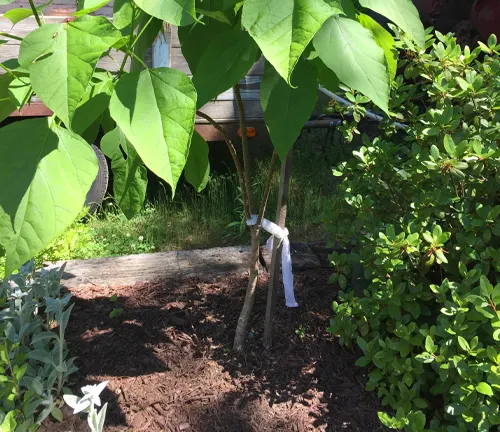
Common Uses
Beyond its natural habitat, the Catalpa tree finds itself embraced for various practical purposes. Its durable wood, though not commonly used in modern construction, has historical significance. Early settlers and indigenous communities utilized Catalpa wood for crafting tools and building materials. Today, the tree’s wood is sometimes employed in specialty woodworking projects. Its adaptability to urban environments also makes it a popular choice for street and park landscaping, further expanding its reach and influence.

Benefits
Embracing the Catalpa tree brings a host of benefits. From its aesthetic contributions to ecological significance, this tree enriches the environment in numerous ways. The shade it provides offers relief on sunny days, and its ability to attract pollinators supports biodiversity. Additionally, the Catalpa’s resilience and adaptability make it a low-maintenance choice for landscaping. Cultivating Catalpa trees in urban and suburban areas not only enhances the visual appeal but also contributes to the well-being of local ecosystems.
Different Species
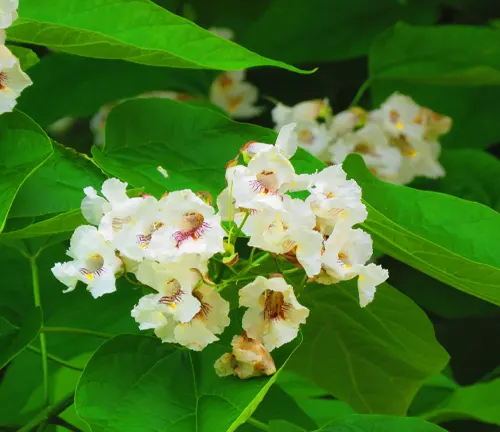
Southern Catalpa (Catalpa bignonioides)
Native to the southeastern United States, the Southern Catalpa is known for its heart-shaped leaves, large showy flowers, and long seed pods. The tree typically reaches a height of 40 to 60 feet and is valued for its ornamental qualities. The flowers are white with purple and yellow markings, creating a striking display in late spring to early summer.

Northern Catalpa (Catalpa speciosa)
Indigenous to the Midwest region of the United States, the Northern Catalpa shares many characteristics with its southern counterpart. It is a larger tree, often reaching heights of 50 to 70 feet, and features similar heart-shaped leaves and showy flowers. The Northern Catalpa is well-adapted to various soil conditions and climates, making it a popular choice for landscaping in a broader range of locations.
Frequently Asked Questions (FAQs)
- What is a Catalpa tree?
A Catalpa tree is a deciduous tree belonging to the Bignoniaceae family. Noted for its large heart-shaped leaves, fragrant flowers, and distinctive long seed pods, Catalpas are commonly found in the eastern United States. - What are the different species of Catalpa trees?
The two most recognized species are the Southern Catalpa (Catalpa bignonioides) and the Northern Catalpa (Catalpa speciosa). - How tall do Catalpa trees grow?
Catalpa trees can reach heights of 40 to 70 feet, creating an impressive and stately presence in the landscape. - When do Catalpa trees bloom?
Catalpa trees typically bloom in late spring to early summer, producing showy clusters of fragrant flowers. - What are the long pods hanging from Catalpa trees?
The long, slender pods hanging from Catalpa trees are often referred to as “cigar trees” due to their elongated shape. These seed pods persist into the winter. - Are Catalpa trees easy to grow?
Yes, Catalpa trees are known for their fast growth and adaptability. They thrive in hardiness zones 5 to 9 and are generally low-maintenance. - What soil conditions do Catalpa trees prefer?
Catalpa trees prefer well-drained soil but are adaptable to various soil types. They can tolerate different conditions, making them versatile in landscaping. - Are Catalpa trees used for landscaping?
Yes, Catalpa trees are popular choices for landscaping due to their ornamental beauty, rapid growth, and adaptability to urban environments. They are often used for shade and as street trees. - Do Catalpa trees have any historical significance?
Yes, Catalpa trees have historical importance. Indigenous people and early settlers used various parts of the tree for medicinal and practical purposes, including crafting tools and building materials. - What is the ecological importance of Catalpa trees?
Catalpa trees contribute to biodiversity by providing habitat and food for various species. They attract pollinators with their fragrant blooms and play a role in soil conservation through their extensive root systems.
- Can Catalpa wood be used for construction?
While Catalpa wood is not commonly used in modern construction, it has historical significance for tool crafting and building materials. Today, it may be used in specialty woodworking projects. - How can I care for a Catalpa tree in my garden?
Catalpa trees are relatively low-maintenance. Provide well-drained soil, regular watering, and ensure they receive adequate sunlight. Pruning may be necessary to maintain shape and remove dead or damaged branches. - Are Catalpa trees suitable for urban environments?
Yes, Catalpa trees are well-suited for urban and suburban areas due to their adaptability and resistance to various environmental conditions. They can thrive in parks, along streets, and in gardens. - Do Catalpa trees have any pests or diseases to watch for?
Catalpa trees may be susceptible to certain pests and diseases, including caterpillars and fungal issues. Regular inspection and appropriate pest management measures can help maintain tree health. - What are the benefits of having Catalpa trees in the landscape?
Catalpa trees offer shade, aesthetic beauty, and contribute to ecological balance. Their adaptability, fast growth, and resilience make them valuable additions to both natural and cultivated environments.




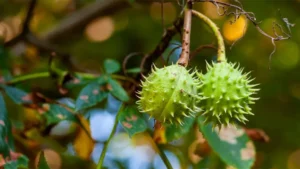
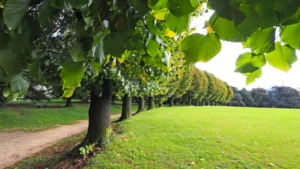
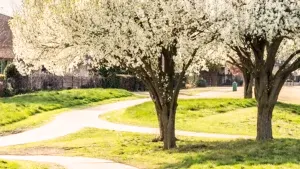

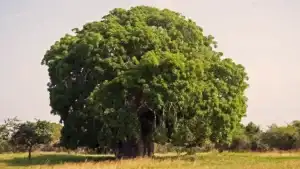
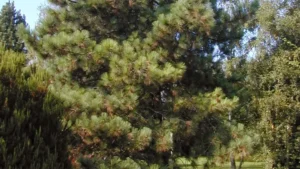

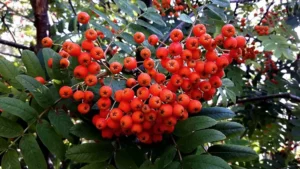

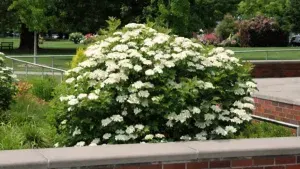
Leave your comment